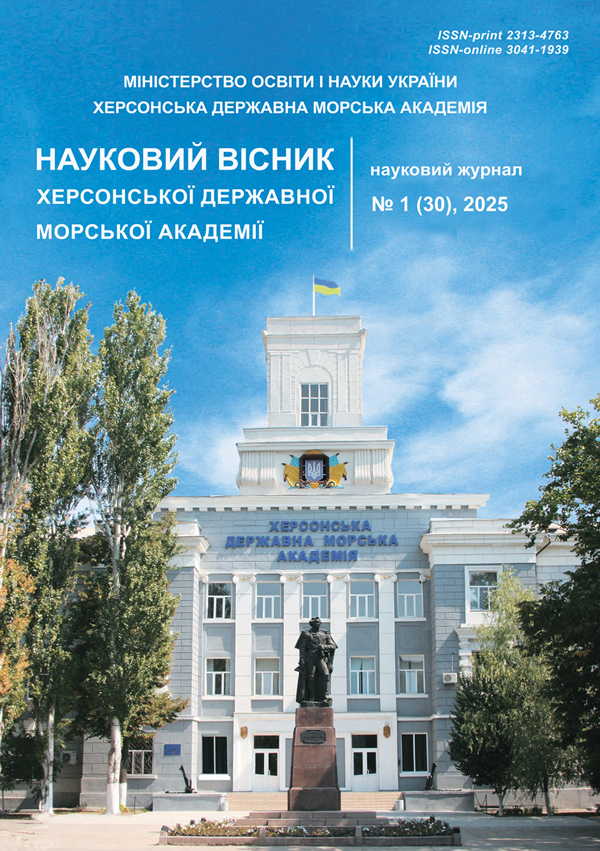MODERN METHODS OF PREVENTING SHIP COLLISIONS AND THEIR APPLICATION IN CONTROLLING AUTONOMOUS SHIPS
https://doi.org/10.33815/2313-4763.2025.1.30.145-156
Abstract
The article is devoted to the issues of applying methods for preventing ship collisions in the processes of controlling unmanned autonomous vessels (UAVs). A range of important issues of the current state of development of the autonomous and unmanned vessel industry is outlined. A comparative analysis of existing methods for preventing ship collisions is conducted. The disadvantages and advantages of each method are identified, as well as the features of their practical application in UAV control. The structure and distinctive features of the process of controlling the movement of autonomous and unmanned vessels in comparison with vessels controlled by a navigator are presented. The peculiarities of the UAV control process are clarified and a range of methods that should be applied for its implementation is determined. The UAV control methods are considered and the architecture of the control system is proposed, which is based on the combined use of fuzzy logic methods, predictive control and explained artificial intelligence. It has been proven that the combination of various methods of processing navigation information and decision-making allows for high-quality control of UAV movement in real time, in the presence of errors and incompleteness of navigation data. Ways of practical implementation of the proposed architecture of the UAV control system and promising directions of further scientific research in this direction are identified.
References
2. IMO. (2019) Autonomous shipping – International Maritime Organization. MSC.1-Circ.1605, London, UK. https://www.imo.org/en/MediaCentre/HotTopics/Pages/Autonomous-shipping.aspx.
3. A. Q. Ansari, Department of Elect. Engg., Faculty of Engg. and Technology, Jamia Millia Islamia, New Delhi-110025, India. The Basics of Fuzzy Logic: A Tutorial Review. https://www.researchgate.net/publication/278031775_The_Basics_of_Fuzzy_Logic_A_Tutorial_Review.
4. Eriksen, B.‐O. H., Breivik, M., Wilthil, E. F., Flåten, A. L., Brekke, E. F. (2019). The branching‐course model predictive control algorithm for maritime collision avoidance. J. Field Robotics. 2019;36:1222–1249. https://doi.org/10.1002/rob.21900.
5. Yujuan Wang, Chao Shen, Jiahui Huang & Hua Chen (2024). Model-free adaptive control for unmanned surface vessels: a literature review. https://doi.org/10.1080/21642583.2024.2316170.
6. Fang, M.-C., Tsai, K.-Y., & Fang, C.-C. (2017). A Simplified Simulation Model of Ship Navigation for Safety and Collision Avoidance in Heavy Traffic Areas. Journal of Navigation, 71(04), 837–860. https://doi.org/10.1017/S0373463317000923.
7. Perera, L. P., Carvalho, J. P., & Soares, C. G. (2012). Intelligent Ocean Navigation and Fuzzy-Bayesian Decision/Action Formulation. IEEE Journal of Oceanic Engineering, 37(2), 204–219. https://doi.org/10.1109/Joe.2012.2184949.
8. Lyu, H., & Yin, Y. (2018). COLREGS-Constrained Real-time Path Planning for Autonomous Ships Using Modified Artificial Potential Fields. Journal of Navigation, 72(3), 588–608. https://doi.org/10.1017/s0373463318000796.
9. Mahini, F., DiWilliams, L., Burke, K., & Ashrafiuon, H. (2013). An experimental setup for autonomous operation of surface vessels in rough seas. Robotica, 31(05), 703–715. https://doi.org/10.1017/S0263574712000720.
10. Serigstad, E. (2017). Hybrid Collision Avoidance for Autonomous Surface Vessels. NTNU. https://doi.org/10.1016/j.ifacol.2018.09.460.
11. Szlapczynski, R., & Krata, P. (2018). Determining and visualizing safe motion parameters of a ship navigating in severe weather conditions. Ocean Engineering, 158, 263–274. https://doi.org/10.1016/j.oceaneng.2018.03.092.
12. Li, S., Liu, J., Cao, X., & Zhang, Y. (2018). A Novel Method for Solving Collision Avoidance Problem in Multiple Ships Encounter Situations. 11184, 47–66. https://doi.org/10.1007/978-3-030-00898-7_4.
13. Shah, B. C., Švec, P., Bertaska, I. R., Sinisterra, A. J., Klinger, W., von Ellenrieder, K., Gupta, S. K. (2015). Resolution-adaptive risk-aware trajectory planning for surface vehicles operating in congested civilian traffic. Autonomous Robots, 40(7), 1139–1163. https://doi.org/10.1007/s10514-015-9529-x.
14. Zhang, W. B., Goerlandt, F., Montewka, J., & Kujala, P. (2015). A method for detecting possible near miss ship collisions from AIS data. Ocean Engineering, 107, 60–69. https://doi.org/10.1016/j.oceaneng.2015.07.046.
15. Zhuang, J. Y., Zhang, L., Zhao, S. Q., Cao, J., Wang, B., & Sun, H. B. (2016). Radar-based collision avoidance for unmanned surface vehicles. China Ocean Engineering, 30(6), 867–883. https://doi.org/10.1007/s13344-016-0056-0.
16. Chen, P., Huang, Y., Mou, J., & van Gelder, P. H. A. J. M. (2018). Ship collision candidate detection method: A velocity obstacle approach. Ocean Engineering, 170, 186–198. https://doi.org/10.1016/j.oceaneng.2018.10.023.
17. Wiig, M. S., Pettersen, K. Y., & Savkin, A. V. (2017). A Reactive Collision Avoidance Algorithm for Nonholonomic Vehicles. 2017 Ieee Conference on Control Technology and Applications (Ccta 2017), 1776–1783. https://doi.org/10.1016/j.ifacol.2021.10.345.
18. Abdelaal, M., Franzle, M., & Hahn, A. (2018). Nonlinear Model Predictive Control for trajectory tracking and collision avoidance of underactuated vessels with disturbances. Ocean Engineering, 160, 168–180. https://doi.org/10.1016/j.oceaneng.2018.04.026.
19. Lazarowska, A. (2017). A new deterministic approach in a decision support system for ship’s trajectory planning. Expert Systems with Applications, 71, 469–478. https://doi.org/10.1016/j.eswa.2016.11.005.
20. Lazarowska, A. (2014). Ship's Trajectory Planning for Collision Avoidance at Sea Based on Ant Colony Optimisation. Journal of Navigation, 68(02), 291–307. https://doi.org/10.1017/s0373463314000708.
21. Kuwata, Y., Wolf, M. T., Zarzhitsky, D., & Huntsberger, T. L. (2014). Safe Maritime Autonomous Navigation With COLREGS, Using Velocity Obstacles. IEEE Journal of Oceanic Engineering, 39(1), 110-119. https://doi.org/10.1109/Joe.2013.2254214.
22. Saurav Sarkar, Soma Das, Ananya Chanda, Sayan Biswas, Classify Chronic Wounds, Explainable and Responsible Artificial Intelligence in Healthcare, https://doi.org/10.1002/9781394302444.ch12, (297-322), (2025).
23. Angelov, P. P., Soares, E. A., Jiang, R., Arnold, N. I., & Atkinson, P. M. (2021). Explainable artificial intelligence: an analytical review. Wiley Interdisciplinary Reviews: Data Mining andKnowledge Discovery, 11(5), e1424. https://doi.org/10.1002/widm.1424.






